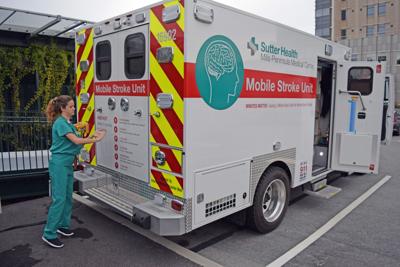When someone suffers from a stroke, time is of the essence. In an effort to cut down on response time, hospitals around the United States have turned to what’s called a mobile stroke unit — a fully functional ambulance equipped with a CT scanner and staffed by specialists to diagnose and begin treatment before patients arrive at the emergency room.
As of Tuesday, Dec. 18, a mobile stroke unit is serving San Mateo County. If a stroke is reported via 911 call, then the unit will be deployed in addition to the standard fire department and ambulance response.
The unit is based out of Mills-Peninsula Medical Center in Burlingame. It’s one of just eight such units in the nation and is the only one operating in Northern California.
“We want to treat more patients in a shorter amount of time so that they get better, have less disability and it’s an improvement both for their quality of life as well as for the health system overall,” said Ilana Spokoynoy, a stroke neurologist staffing the unit.
In the event of a clotting stroke, which occurs in about 85 percent of patients, medication will be administered in the mobile stroke unit to break up the clot, according to a press release. Patients suffering from bleeding strokes will be transported to the nearest stroke center.
In San Mateo County, there are three to five stroke calls per day and Mills-Peninsula sees about one third of those calls. Strokes are the fifth leading cause of death in the United States and a leading cause of long-term disability, according to the Centers for Disease Control and Prevention.
“Studies show that for every minute you’re not treating a stroke, the patient is potentially losing 2 million brain cells,” said Jenny Im, a nurse who has helped develop the county’s MSU program. “If we can cut down 10 minutes, 15 minutes, 30 minutes, that will in theory have a better outcome with the patient.”
This particular unit is part of a clinical trial collecting data on the unit’s effectiveness at treating clotting strokes specifically.
“We all assume that a mobile stroke unit will allow us to treat patients in a shorter amount of time, and we all assume that’s going to be better for patient outcomes because we’ve shown it for other clinical trials, but until we prove that then other counties aren’t going to have the evidence to back up the push to get a mobile stroke,” Spokoynoy said.
The unit costs $1 million and the 1,000-pound CT scanner, which has to be specially installed to withstand a crash and prevent radiation from escaping, costs half of that.
The unit was funded by local philanthropy and will be in operation for at least a two-year pilot program, estimated to cost $3.4 million. Money is still being raised and part of the point of the pilot is to determine whether the unit is cost effective.
The unit is staffed by five people: a paramedic, EMT, physician, CT technologist and stroke nurse. The unit will eventually be equipped with what’s called Telemedicine, a Facetime-like system that allows a physician to staff the unit remotely.
The pilot program is the result of a partnerships with American Medical Response, EMS, public safety and local fire departments.
“I think this is just the beginning for seeing what we can do for stroke care in the community,” Im said.

























(0) comments
Welcome to the discussion.
Log In
Keep the discussion civilized. Absolutely NO personal attacks or insults directed toward writers, nor others who make comments.
Keep it clean. Please avoid obscene, vulgar, lewd, racist or sexually-oriented language.
Don't threaten. Threats of harming another person will not be tolerated.
Be truthful. Don't knowingly lie about anyone or anything.
Be proactive. Use the 'Report' link on each comment to let us know of abusive posts.
PLEASE TURN OFF YOUR CAPS LOCK.
Anyone violating these rules will be issued a warning. After the warning, comment privileges can be revoked.